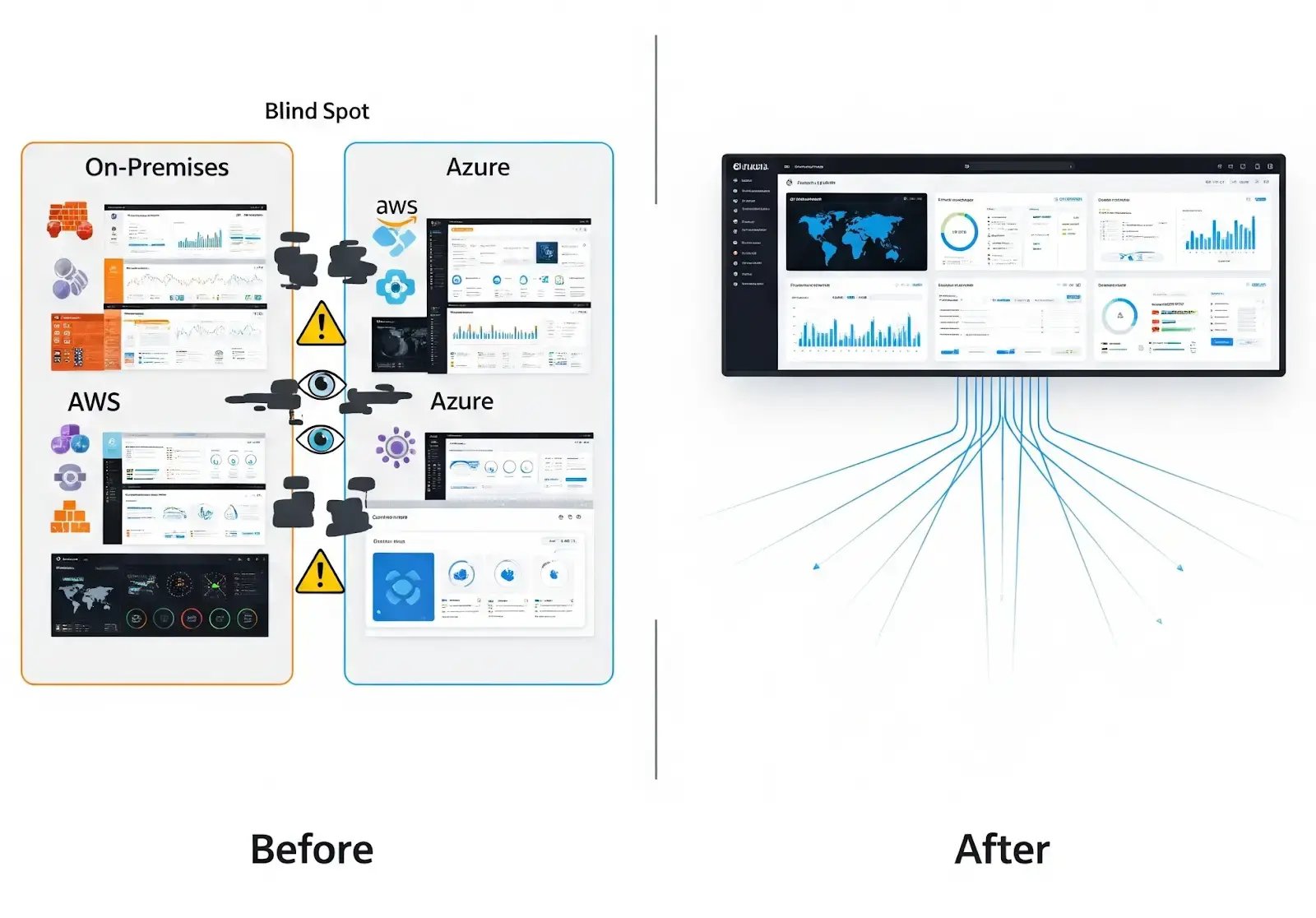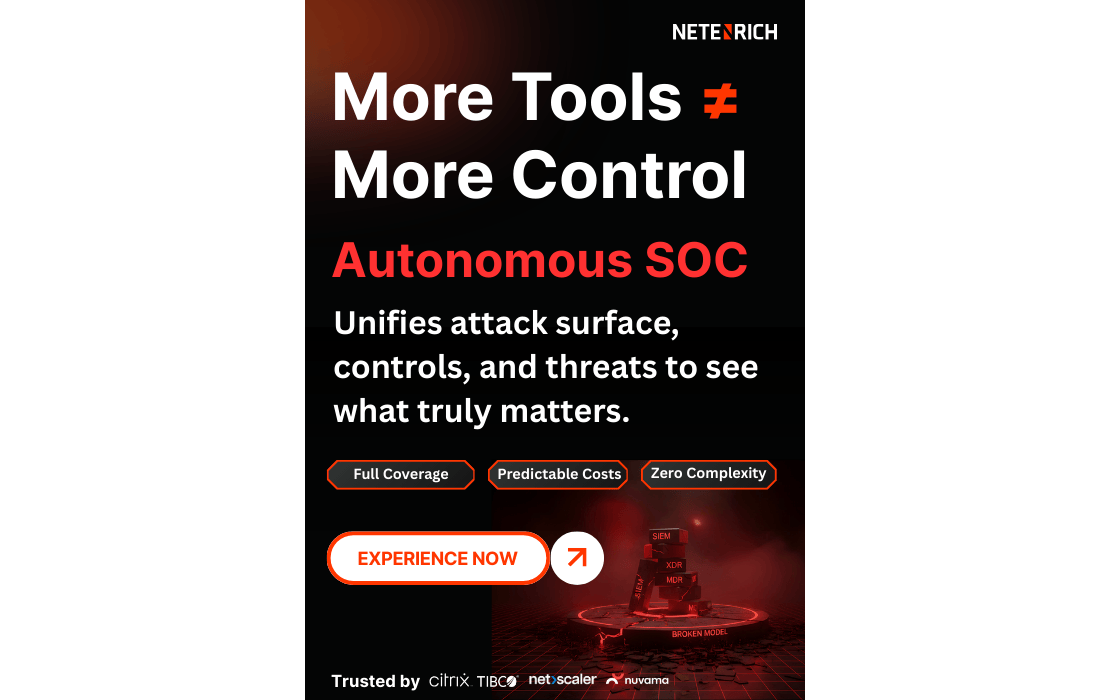Hybrid Cloud Security Risks? How to Achieve Consistent Protection
Published on November 3, 2025 | Last updated on November 12, 2025 | 5 min read

Key Takeaways
- Hybrid cloud environments increase security fragmentation, creating blind spots, inconsistent policies, and a larger attack surface.
- Disjointed tools, data, and teams delay detection and drive up breach costs, averaging $4.75M per incident.
- Aligning telemetry, policies, and dashboards simplifies operations and strengthens visibility across hybrid environments.
- Automation and zero-trust enforcement reduce human error, close configuration gaps, and accelerate incident response.
- Netenrich Adaptive MDR centralizes detection and response, delivering continuous coverage, adaptive security, and measurable security outcomes.
Securing IT infrastructure is never simple, and hybrid cloud environments raise the stakes further. It’s like managing a single-family home alongside multiple rental apartments, each with its own unique locks, security systems, and keys – mixed security systems lead to fragmented visibility, creating blind spots, policy inconsistencies, and unnecessary complexity.
According to Virtana, 80% of organizations1 now use a mix of public and private clouds in addition to their on-premise systems. Such hybrid environments pose security challenges due to fragmented intelligence, overwhelming signals, and the inability to accurately determine what is and isn't relevant.
Cyber attackers are well aware of this. According to IBM's Cost of a Data Breach 20232 Report, hybrid cloud breaches cost organizations $4.75M on average, significantly higher than public or private cloud alone.
CISOs and boards cannot afford to ignore the negative business impact of patching together random solutions. Achieving consistency across environments and automating security at scale is now a business imperative, and security leaders must solve any challenge standing in the way of achieving it.
Why Are Hybrid Cloud Environments Harder to Secure?
Hybrid cloud environments come with a major security challenge: fragmentation. This fragmentation affects data, tools, controls, and even visibility. Attackers often exploit these gaps, and defenders fail to close them.
- Fragmented visibility: Private and public clouds have distinct monitoring tools, log structures, and security dashboards that collect information and store that intelligence in diverse ways. Tracking and stitching these together often leaves blind spots, which delays threat detection.
- Inconsistent policies and controls: A non-uniform enforcement of security policies and controls, both on-premises and across cloud infrastructure, leads to misconfigurations and configuration drift. According to Veritis, misconfigurations are responsible for over 60% of cloud breaches.
- Increased attack surface: Hybrid cloud environments that unify on-premises and cloud infrastructure create a larger attack surface with multiple entry points for bad actors.
- Gaps in specialized knowledge: Hybrid cloud defense demands expertise in Kubernetes, IAM, cloud-native services, and legacy infrastructure. Not many security professionals have that background, which complicates defending hybrid cloud environments.
- Added complexity via tool sprawl: Hybrid cloud environments employ a variety of tools. While security teams already use several tools in their day-to-day work, the additional complexity of the hybrid cloud only exacerbates those challenges. This overload worsens alert fatigue, slowing down response and defense.
The need of the hour is a unified data model. As noted in the CISO Roundtable in December 2023, “A unified data model must accommodate alerts from multiple systems, such as CloudWatch, Google Chronicle, and on-premise telemetry.”
How Can Security Teams Close Hybrid Cloud Security Gaps?
It is possible to bridge the gaps in cloud security. Firstly, organizations should focus on having the right people in place. Base security policies should also be implemented consistently across all environments. They should also focus on a zero-trust network model to enforce verified access across all networks, assets, and users, regardless of their location.
- Unify dashboards: Teams need fewer dashboards, not more. To accomplish this, a centralized platform that aggregates logs, telemetry, and alerts, gives a holistic view of the attack surface, and accelerates incident response, is ideal.

- Automate policy enforcement: Manual enforcement across platforms can lead to errors. Automation ensures consistent baselines, detects drift, and applies guardrails from day one of deployment. This reduces the possibility of human error and ultimately ensures that deployments are secure from the start.
- Adopt a zero-trust policy: Every user, device, and app must be verified continuously. This limits lateral movement, even if attackers breach one system.
- Consolidate Identity and access management: Consolidate IAM systems for consistent access controls and MFA across all systems to shrink the attack surface.
- Skills and cultural shift: Revamping technology alone won’t solve hybrid cloud security. Teams must adopt security practices and cross-functional collaboration between cloud engineers and security staff. Along with this, regular training and upskilling of security staff can help close the talent gap.
Integrating Your Existing Tools for Consistent Protection
Most security teams already have a powerful array of prevention, detection, and response tools. The challenge isn’t a shortage of technology; it’s the lack of integration between them.
A typical hybrid cloud environment relies on:
- Prevention tools such as CNAPP, CASB, and IAM are employed to harden the attack surface.
- Detection tools such as SIEM and CSPM are used to identify threats in progress.
- Response tools such as SOAR and XDR are designed to take swift, coordinated action.
But without a unification strategy, these tools operate in silos, creating the same blind spots they’re meant to eliminate. Data scattered across dashboards forces analysts to connect the dots manually, delaying detection and slowing response.
The goal isn’t to add more tools, it’s to integrate their signals into one coherent view. A unified data model ensures alerts, telemetry, and context flow together, enabling analysts to see the entire attack surface and act with precision. In hybrid environments, this integration is what transforms a fragmented stack into a resilient, adaptive defense.
That’s exactly what Netenrich Adaptive MDR delivers: unified visibility, automated correlation, and continuous coverage across every cloud and on-prem system.
How does Netenrich Adaptive MDR Unify Hybrid Cloud Security?
Netenrich's Adaptive Managed Detection and Response acts as a single, centralized platform for continuous security operations. The solution unifies expert-led operations, structured response workflows, and an integrated technology stack. Adaptive MDR combines scalable telemetry, behavioral analytics, and AI-powered automation, designed to strengthen your security operations and keep business moving.
Adaptive MDR is not a static managed service. This is ‘Automating the Known’ in action, removing repetitive manual work so analysts can focus on evolving hybrid risks. It’s a continuously evolving security system engineered to improve, tune, and align itself to your environment, risks, and outcomes. This includes features like:
- Continuous Coverage Intelligence: Signal analytics, coverage maps, and drift tracking that identify blind spots and offer continuous recommendations.
- Adaptive Detection and Response: Detection rules in Adaptive MDR continuously evolve based on data quality and behavioral context, while SOAR playbooks are validated every month, and custom detections evolve with each ActOn trigger.
- Data and Signal Health Monitoring: Real-time validation of log ingestion quality and data completeness, alongside automated flagging and resolution of issues like timestamp drift, parsing errors, or MITRE misalignment. These trends inform the detection strategy as well as tool optimization.
- Alignment With Business and Risk: Adaptive MDR prioritizes controls based on critical assets and compliance requirements.
- Integrated Operational Feedback Loops: Tracking of KPIs like MTTD, MTTR, signal-to-ActOn ratio, and fidelity trends, with delivery adjusting dynamically based on environmental changes.
What Hybrid Cloud Security Results Come From Consistency?
Consistency in hybrid cloud security drives a number of operational benefits as well as security ones. This includes the obvious benefit of enhanced security posture by limiting the gaps in your monitoring and processes, as well as improving incident response with a unified view and automated workflows that can respond to threats faster and more effectively, minimizing the damage of a breach.
This also drives simplified operations through tool and process consolidation, cutting operational complexity and causing alert fatigue. This was exactly what Citrix achieved with Netenrich.
According to Andy Nallappan, President and COO, Citrix Cloud Software Group,
"Netenrich has transformed our security operations by delivering meaningful and measurable results. Their Adaptive MDR solution slashed our annual security costs by over 50% while reducing our response times to an impressive 15 minutes. With enhanced detection performance and a scalable framework, we are better equipped to safeguard our business and proactively adapt to future security demands."
The reduction in time spent on chasing false positives and irrelevant security alerts can't be overstated. A consistent approach in cloud security ensures that teams aren't spending their time on low-level issues. Rather, this ensures that analysts spend their time on major security issues.
Consistency also drives better compliance. A unified security framework can help you streamline audits for PCI DSS, HIPAA, and GDPR, with consistent evidence and policies.
Hybrid cloud security is incredibly challenging. It's unlikely to get easier with the added complexity of multiple environments, but it is possible to mitigate this complexity and ensure improved security. Applying zero-trust, enforcing consistent policy, and integrating automation is a clear path forward for organizations. Netenrich Adaptive MDR powered by Google SecOps can make that happen.
References:
https://www.cloudzero.com/blog/cloud-computing-statistics/
https://www.ibm.com/reports/data-breach
Related Articles
Subscribe for updates
The best source of information for Security, Networks, Cloud, and ITOps best practices. Join us.








